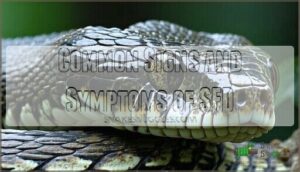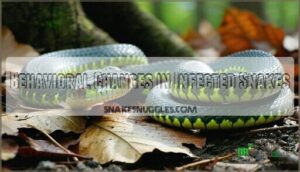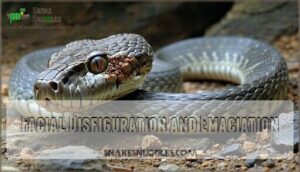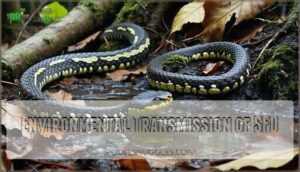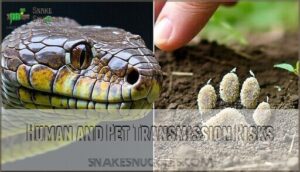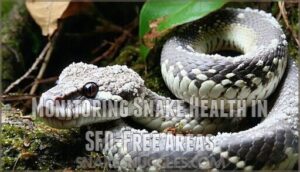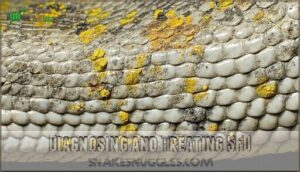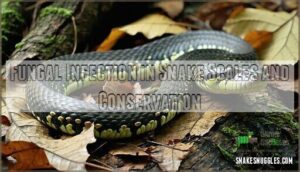This site is supported by our readers. We may earn a commission, at no cost to you, if you purchase through links.
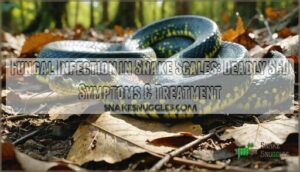
You’ll spot it through facial swelling, crusty lesions, and abnormal shedding patterns on your snake’s scales.
The infection spreads through contaminated environments and affects wild snakes across 23 states.
SFD can’t jump to humans or pets, but proper hygiene prevents spread between snakes.
Unfortunately, treatment options remain limited, and many infected snakes don’t survive.
Early detection gives your scaly friend the best fighting chance.
While researchers work on solutions, understanding the warning signs could mean the difference between life and death for these remarkable reptiles.
Table Of Contents
- Key Takeaways
- Snake Fungal Disease Basics
- Identifying SFD in Snakes
- Transmission and Prevention of SFD
- Diagnosing and Treating SFD
- Fungal Infection in Snake Scales and Conservation
- Frequently Asked Questions (FAQs)
- Is snake fungal disease contagious to humans?
- What does snake fungal disease look like?
- How to get rid of fungal infection on snake plant?
- How does a snake get a fungal infection?
- What is the mortality rate for snake fungal disease?
- What is antifungal treatment for snakes?
- How do you treat fungal disease in snake plants?
- How do environmental changes influence snake fungal infections?
- Are certain snake species more immune to SFD?
- Can climate adaptation strategies mitigate SFD risks?
- Conclusion
Key Takeaways
- You’ll recognize SFD by crusty, thickened scales and facial swelling – Look for yellow-brown scabby lesions, skin nodules, and cloudy eyes that aren’t related to normal shedding patterns.
- The disease can’t infect you or your pets, but you can spread it between snakes – Always wash your hands and use gloves when handling snakes to prevent contaminating other areas through soil or equipment.
- Early detection gives infected snakes their best survival chance – With mortality rates reaching 40%, spotting symptoms quickly before the infection reaches deep tissues is crucial for treatment success.
- SFD threatens entire ecosystems by reducing snake populations – When snakes die from this fungal infection, rodent populations explode without their natural predators, disrupting the balance of local food webs.
Snake Fungal Disease Basics
If you’ve ever wondered about that crusty, scabby stuff on a snake’s scales, you’re looking at a potentially deadly fungal infection called Snake Fungal Disease (SFD).
This nasty disease, caused by the fungus Ophidiomyces ophiodiicola, has been quietly wreaking havoc on snake populations across North America since scientists first spotted it in New Hampshire back in 2006, causing a significant impact due to its deadly nature.
Definition and Cause of SFD
Snake Fungal Disease (SFD) strikes when you least expect it. This causative fungus called Ophidiomyces ophiodiicola lives as an environmental saprobe in soil, thriving across diverse pH tolerance levels.
Here’s what you need to know:
- Incubation period ranges from 12-37 days after exposure
- Mortality rate can reach 40% in affected populations
- Targets snake scales with devastating fungal infection
- Survives harsh conditions including drought
History of SFD Discovery and Spread
When did scientists first identify this emerging infectious disease? Initial Identification occurred in 2006 when researchers discovered Snake Fungal Disease among New Hampshire’s timber rattlesnakes.
Geographic Expansion followed rapidly, with Ophidiomyces ophiodiicola spreading across 26 U.S. states by 2019.
The disease is caused by Ophidiomyces ophiodiicola fungus. Detection Challenges and Monitoring Underreporting suggest this emerging infectious disease existed decades before causing visible population declines.
Impact on Snake Populations and Ecosystems
Why would snake fungal disease devastate entire ecosystems? When population decline strikes snake communities, the ecological impact ripples through food webs like falling dominoes.
Without adequate genetic diversity and effective conservation strategies, species vulnerability increases dramatically. The disease is caused by Ophidiomyces ophiodiicola fungus.
- Rodent populations explode without natural snake predators controlling them
- Ecosystems lose critical balance as prey species multiply unchecked
- Snake populations face local extinction without immediate intervention efforts
Identifying SFD in Snakes
You’ll spot Snake Fungal Disease through visible skin changes like crusty scales, facial swelling, and unusual bumps under the skin.
Infected snakes also show odd behaviors like basking too long or moving around during cold weather when they should be hiding, which can be a clear sign of Snake Fungal Disease.
Common Signs and Symptoms of SFD
How can you spot snake fungal disease before it’s too late? Watch for crusty scales, facial swelling, and cloudy eyes unrelated to shedding.
You’ll notice skin nodules and lethargic behavior in infected snakes.
| Symptom | Description |
|---|---|
| Crusty Scales | Thickened, scabby appearance |
| Facial Lesions | Swelling and disfigurement |
| Skin Nodules | Bumps under the skin |
| Cloudy Eyes | Opaque appearance (not molting) |
| Behavioral Changes | Wandering in cold weather |
Skin Changes and Lesions in SFD
Your snake’s healthy scales can transform into yellow-to-brown crusty scales with blister formation and ulcerated areas.
Scale discoloration signals trouble, while nodules development creates bumps beneath the skin.
Watch for facial lesions that worsen over time.
Severe tissue invasion reaches muscles and organs, making early detection vital for snake fungal disease treatment success.
Behavioral Changes in Infected Snakes
Why do infected snakes act so strangely? Lethargy/Aggression replaces normal behavior as snake fungal disease disrupts their systems.
You’ll notice Activity Changes like unusual Basking Behavior during cold weather or complete inactivity. Feeding Difficulties become common as infected snakes lose appetite entirely.
This odd behavior stems from discomfort and weakened immunity. Aggressive behavior may flare unexpectedly.
These behavioral changes increase Predation Risk since sick snakes can’t escape threats effectively.
Facial Disfiguration and Emaciation
As facial disfigurement progresses, you’ll notice severe feeding difficulties and vision impairment that quickly lead to emaciation.
The snake fungal disease destroys facial muscle atrophy, making it nearly impossible for snakes to hunt effectively.
Telltale signs include crusty, swollen snake scales around the eyes and snout.
This organ damage creates mortality factors that threaten survival, making early detection of this fungal infection snakes face absolutely critical.
Transmission and Prevention of SFD
You can easily prevent SFD by understanding how this sneaky fungus spreads through contaminated soil, water, and direct contact between snakes.
Simple precautions like washing your hands, wearing gloves, and keeping your outdoor gear clean will protect both you and the snakes you encounter, and are key to preventing the spread of SFD through contaminated soil and water.
Environmental Transmission of SFD
Understanding how snakes get SFD helps you protect wild populations from this devastating disease.
Environmental transmission happens when Soil Contamination and Water Sources harbor the fungus.
You’ll find these contaminated environments everywhere:
- Infected hibernation dens where spores linger year-round
- Contaminated soil that spreads through human foot traffic
- Water sources carrying fungal particles between habitats
Mortality rates can vary, but systemic infections are possible if the disease progresses.
Fungal Persistence makes environmental conditions the primary threat to snake health.
Human and Pet Transmission Risks
SFD poses zero risk to you or your furry friends—this fungus exclusively targets snakes.
However, Pet Exposure and Human Contact create Contamination Pathways through soil on shoes or equipment.
You can accidentally spread fungal spores between locations, threatening wild populations.
To guarantee safety, consider specialized handling equipment when interacting with snakes.
Risk Mitigation requires strict Hygiene Practices: always use glove use and thorough handwashing after snake handling to prevent human transmission and pet transmission via contaminated surfaces.
Handwashing and Glove Use in Snake Handling
When handling snakes, proper protective measures prevent spreading fungal infections.
Handling protocols require latex, nitrile, or cotton gloves as glove material barriers.
Handwashing effectiveness depends on thorough scrubbing before and after contact.
This simple preventive measure maintains environmental hygiene while reducing zoonosis risks.
High-quality snake handling gloves offer enhanced protection.
Public awareness about these snake handling basics protects both humans and reptiles from contamination.
Monitoring Snake Health in SFD-Free Areas
Three key strategies help you protect snake populations in areas without snake fungal disease.
Early detection through baseline data collection and population surveys creates your foundation for monitoring snake health.
Conduct regular health assessments and habitat monitoring to spot disease surveillance warning signs before they spread.
Consider specialized tools available for effective monitoring.
Think of it as being a detective – you’re gathering clues about snake health problems to prevent future outbreaks.
Diagnosing and Treating SFD
When SFD strikes your snake, you’ll need professional help to confirm what you’re dealing with and figure out the best treatment plan.
Veterinarians use lab tests like PCR and tissue samples to diagnose the fungus, then typically prescribe antifungal medications—though success rates aren’t great and early action gives your snake the best fighting chance to receive antifungal medications.
Laboratory Diagnosis of SFD
Accuracy becomes vital when diagnosing SFD through specialized diagnostic tools. Laboratory diagnosis requires multiple approaches to confirm infection.
PCR testing detects fungal DNA with high sensitivity, while culture methods isolate living organisms for identification. Histopathology reveals tissue damage patterns, ensuring thorough fungal identification.
- Swab skin lesions for PCR analysis
- Collect tissue biopsies for culture methods
- Use histopathology to examine infected scales
- Combine multiple tests for accurate diagnosis
- Prioritize early diagnosis for better outcomes
Treatment Options for SFD in Snakes
Several treatment options exist for SFD-infected snakes.
Systemic antifungals like terbinafine and itraconazole show promise, though antifungal efficacy varies by species.
Topical antifungals treat surface lesions directly.
Surgical intervention removes damaged tissue when needed.
Supportive care including proper temperature, hydration, and nutrition boosts recovery chances.
Resistance concerns make tailored plans essential for each case.
Limited Treatment Success and Mortality Rates
While treatment options exist, snake fungal disease presents significant Treatment Challenges.
Mortality rates reach 40% in experimental studies, with Species Variation affecting outcomes dramatically.
Antifungal treatment shows inconsistent results due to Fungal Resistance and Stress Impact from captivity.
Limited treatment success demands Long-Term Strategies:
- Eastern massasaugas face 95% mortality in outbreaks
- Colubrid snakes resist standard antifungal protocols
- Triazole medications cause toxicity in many patients
- Recurrence occurs despite apparent recovery
Importance of Early Detection and Treatment
Early detection serves as your best defense against snake fungal disease progression.
When you spot snake skin lesions quickly, antifungal treatment becomes far more effective.
This timing dramatically boosts improved survival rates while helping minimize damage to affected populations.
The disease spreads through contaminated soil vectors.
Quick action prevents the worst outcomes:
- Reduced spread – Early intervention stops fungal spores from contaminating new areas
- Species preservation – Protecting vulnerable populations like timber rattlesnakes and milk snakes
- Treatment efficacy – Antifungal medications work best before deep tissue invasion occurs
- Cost savings – Prevention beats expensive emergency wildlife rehabilitation efforts
- Ecosystem stability – Healthy snake populations maintain balanced predator-prey relationships
Remember, once disease progression reaches facial disfigurement stages, even aggressive treatment often fails.
Fungal Infection in Snake Scales and Conservation
When you discover those crusty, thickened scales on a snake, you’re looking at more than just a skin problem—you’re witnessing a conservation crisis that’s quietly threatening snake populations across North America.
Snake Fungal Disease doesn’t just make individual snakes sick; it’s reshaping entire ecosystems by reducing the numbers of these important predators who keep rodent populations in check, which is a significant issue affecting ecosystems.
Fungal Infection in Snake Scales and SFD
Ophidiomyces ophiodiicola transforms your snake’s protective scales into vulnerable entry points.
This fungal infection disrupts the scale microenvironment, overwhelming the skin microbiome’s natural defenses.
Genetic predisposition and molting impact determine how severely SFD affects individual snakes.
The fungal virulence increases when environmental conditions favor pathogen growth over healthy scale maintenance.
Impact of SFD on Rattlesnake and Other Species
Snake Fungal Disease threatens rattlesnake populations and dozens of other species across North America.
Ophidiomyces ophiodiicola causes population declines by targeting vulnerable snake scales, reducing genetic diversity and population resilience.
Species susceptibility varies, but timber rattlesnakes face particularly severe rattlesnake decline.
These ecosystem effects ripple outward, disrupting predator-prey relationships and biodiversity balance.
The disease is detectable through localized skin lesions.
Conservation Efforts for SFD-Affected Snakes
Protecting snake populations from this devastating wildlife disease starts with you.
Habitat restoration creates safe spaces where snakes can thrive without environmental stressors that worsen infections.
Captive breeding programs help maintain genetic diversity while population monitoring tracks disease spread.
Public awareness campaigns educate communities about prevention.
- Habitat restoration – Preserve hibernacula and riparian areas to reduce transmission
- Captive breeding – Maintain genetic diversity in threatened populations
- Population monitoring – Track infection rates and mortality in wild snakes
- Public awareness – Prevent release of infected captive snakes into wild habitats
Research and Future Directions in SFD
Future research focuses on Genetic Resistance and Immunological Response patterns in snake populations.
Scientists are developing Novel Therapies and Predictive Modeling to forecast outbreaks before they devastate communities.
Environmental Factors like climate change complicate disease modeling efforts.
You’ll see breakthrough diagnostics emerge as researchers race to understand Ophidiomyces ophiodiicola better.
This Snake Fungal Disease research could save entire species from extinction.
Frequently Asked Questions (FAQs)
Is snake fungal disease contagious to humans?
Ironically, you’re probably safer around snakes with fungal disease than your average doorknob.
Snake fungal disease isn’t contagious to humans, though you should wash your hands after handling infected snakes as basic hygiene practice.
What does snake fungal disease look like?
You’ll notice crusty, thickened scales that look scabby or discolored yellow-brown. Infected snakes develop facial swelling, skin ulcers, abnormal bumps under scales, and cloudy eyes unrelated to shedding.
How to get rid of fungal infection on snake plant?
Remove infected plants immediately, improve air circulation, reduce watering frequency, apply fungicide spray, and make certain proper drainage. Check soil moisture before watering—overwatering causes most fungal problems.
How does a snake get a fungal infection?
When the chips are down, snakes catch fungal infections through contaminated soil, water, or direct contact with infected snakes.
The fungus Ophidiomyces ophiodiicola thrives in humid environments and enters through damaged skin.
What is the mortality rate for snake fungal disease?
You’ll find snake fungal disease carries a mortality rate reaching 40% in some studied populations. The incubation period ranges from 12 to 37 days after exposure, making early detection essential.
What is antifungal treatment for snakes?
Like a medical arsenal against microscopic invaders, you’ll battle fungal infections with systemic antifungal medications.
Topical treatments applied directly to lesions are also part of the strategy.
Supportive care, including proper thermal regulation, hydration, and nutrition, is crucial to boost recovery chances.
How do you treat fungal disease in snake plants?
To treat fungal infections in snake plants, you’ll need proper drainage, reduced watering, antifungal treatments, and removing affected leaves.
Improve air circulation around your plant and adjust humidity levels for ideal recovery.
How do environmental changes influence snake fungal infections?
Environmental changes hit snake health like a perfect storm.
You’ll find that stress from temperature drops, humidity shifts, and habitat disruption weakens their immune systems, making snakes more vulnerable to fungal infections.
Are certain snake species more immune to SFD?
No snake species show complete immunity to SFD.
However, you’ll find disease severity varies substantially among species.
Some populations demonstrate better resistance than others, likely due to genetic factors, environmental conditions, and individual immune responses affecting susceptibility levels.
Can climate adaptation strategies mitigate SFD risks?
Fighting nature’s curveball requires smart moves.
You can reduce SFD risks through proper habitat management, maintaining ideal humidity levels, minimizing stress factors, and avoiding contaminated areas during vulnerable periods like post-hibernation.
Conclusion
Understanding fungal infection in snake scales through SFD awareness is your secret weapon against this deadly threat.
Like medieval physicians battling the plague, you’re now equipped with knowledge to identify symptoms early.
Watch for facial swelling, crusty lesions, and abnormal shedding patterns.
Practice proper hygiene when handling snakes, and contact wildlife authorities if you spot infected animals.
Early detection remains the best hope for survival in affected populations.
- https://pmc.ncbi.nlm.nih.gov/articles/PMC5095536/
- https://cwhl.vet.cornell.edu/disease/snake-fungal-disease
- https://www.cwhc-rcsf.ca/docs/fact_sheets/SFD_FactSheet.pdf
- https://www.merckvetmanual.com/exotic-and-laboratory-animals/reptiles/mycotic-diseases-of-reptiles
- https://digitalcommons.augustana.edu/cgi/viewcontent.cgi?article=1621&context=celebrationoflearning

